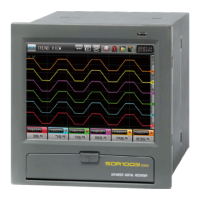106
EUS(-100~100%)
EU(0 ~ 100%)
EU(-100~100%)
| RH - RL |
| RH - RL |
EUS(0 ~ 100%)
0 RHRL
| RL || RH |
(Example)
▶ INPUT = T/C(K2)
▶ RANGE = -200.0℃(RL) ~ 1370.0℃(RH)
EU(0 ~ 100%)
EU(-100 ~ 100%)
EUS(0 ~ 100%)
EUS(-100 ~ 100%)
RL ~ RH
-( | RH - RL | + | RL | ) ~ RH
0 ~ | RH - RL |
- | RH - RL | ~ | RH - RL |
| RH - RL |/2 + RL
RL
| RH - RL |/2
0
EU(0 ~ 100%)
EU(-100 ~ 100%)
EUS(0 ~ 100%)
EUS(-100 ~ 100%)
- 200.0 ~ 1370.0℃
- 1770.0 ~ 1370.0℃
0 ~ 1570.0℃
- 1570.0 ~ 1570.0℃
585.0℃
- 200.0℃
785.0℃
0.0℃
Engineering Units - EU, EUS
When the sensor type (IN-T) or the upper limit.lower limit of input range is changed, the parameters expressed in EU( ), EUS( ) are changed in
proportion to current data. (However, the upper and lower range setting data is initialized.)
Download the instruction manual and communication manual from the homepage.
EU( ) : Value of engineering unit depending on the range of instrument
EUS( ) : Value of engineering unit depending on the span of instrument
Range Center point
▶ Range of EU( ) and EUS( )
Range Center point
RL: Lower limit of input range
RL: Upper limit of input range

